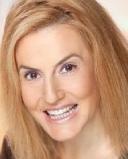Spirituality
Moving Beyond the Mind's Limits
A Personal Perspective: What is intuitive and extraordinary knowing?
Updated June 21, 2024 Reviewed by Lybi Ma
.jpg?itok=ammeiDXz)
A lot of attention is given to the unconscious, and for good reason. Making the unconscious conscious is an important part of healing and well-being. However, our point of empowerment doesn’t end there. The sweet spot for transcending human limitation rests in inexplicable expanded awareness. Why do people seek this? Simply put, the experience of this state of mind can be exhilarating, sparks pervasive knowing, and is deeply peaceful. How do we get there? For some, it’s dumb luck; others might call that divine timing or grace. This was my experience. For others, it arrives after years of practicing meditation.
The Empathy and Intuition Continuum
Extraordinary conscious states of knowing reside at the far reaches of empathy and intuition.1 These conscious states transcend space and time, and they are associated with a higher level of creativity and spiritual awareness that many of us have known, albeit fleetingly. Examples of transcendent states are heightened moments in the arts and sports, as well as in drug-induced, religious, and meditative experiences. While extraordinary knowing remains challenged in some contemporary psychoanalysis circles, it requires more examination. This level of consciousness involves a knowing at the higher levels of consciousness called universal consciousness, in which we are all one and have access to all knowledge. More simply put, extraordinary consciousness is the attempt of human beings to understand the numinous. Subtler states of consciousness emerge as we go beyond our ordinary senses and we experience states of rapture, bliss, and equanimity. In these realms, subject and object dissolve, and we can experience states of grace and compassion that expand our ways of knowing and being.
Years ago, I had an extraordinary moment with a wild gray whale who spy-hopped while I was paddleboard surfing, which gave me the sense of wholeness that characterizes spiritual connection.2 I called her Molly, whose soulful gaze welcomed me into an infinite, blissful universe, where my internal introject shifted from disappointing and critical to more loving, benevolent, and attuned. In Molly’s recognition, I felt acknowledged with a new sense of empathic unconscious and could articulate an inner empathic dialogue. This experience changed me forever and provided the emotional sanctuary where I could begin to reexamine and suspend my old beliefs about what I was taught and make room for not knowing and the unknown.
The Art of Extraordinary Knowing
This process has been further explored by Elizabeth Lloyd Mayer, the late classical psychoanalyst, whose process shifted to incorporate the art of extraordinary knowing.3 When her daughter’s rare harp was stolen and despite all efforts could not be located, she hired a dowser who specifically located lost objects. From Arkansas, the dowser told her the exact street in California the harp was on, and Mayer was able to retrieve it. This uncanny experience changed how she worked as a psychoanalyst. Mayer wrote about Grace, a patient who had unusual intuitive capacities to survive a traumatic childhood with a violent alcoholic father. Grace suddenly knew, “by listening with my whole body, not my ears,” that her father was 15 minutes away and driving home drunk. She would hustle her sister and herself into the closet to avoid his uncontrollable violence. She knew because she had to. Mayer describes patients similar to Grace, who developed extraordinary intuition through no known sensory means, to survive traumatic circumstances that required knowing more than people can usually perceive.
Cynthia Bourgeault, a Christian priest who teaches how to know through meditation and breath, refers to the ensuing wisdom as “seeing with the eye of the heart.”4 By slowing down the breath, one may reach a deeper state of relaxation that allows for openness and for deeper empathic intuitiveness to develop. Bourgeault went beyond the intellectual and rational way of thinking and embodied body, mind, and spirit. Through contemplative practices and sitting still, one creates a place, apart from the chaos, to allow deeper insights to emerge. Tapping into a so-called "contemplative intelligence” is an authentic way of knowing, and harnessing a deeper source of self.
I, too, changed the way I work and live, professionally and personally, as a direct result of my experiences. Extraordinary knowing gently takes you by the hand to a new, expanded space where any beliefs you were taught in the world are suspended.
While meditating before seeing a patient, Ben, I was close to being in psychoanalyst Wilfred Bion’s concept of “O”, although I only realized that in retrospect.5 By suspending my ego, memory, and desire for future hopes for Ben, the space for something unknown and new emerged, which enlivened and transformed the analysis. Bion felt that even the therapist’s wish for the patient to heal must be abandoned, to avoid interfering with evolving truths within the present moment. He referred to those moments as transformations in O, the unified single source in which all consciousness—known and unknown—arises. Now that’s an unforgettable and long-lasting Big O.
References
Mayer, EL. (2007). Extraordinary Knowing: Science, Skepticism, and the Inexplicable Powers of the Human Mind. Bantam Dell.
Bourgeault, C. (with Moore, T. ) (2003). The Wisdom Way of Knowing: Reclaiming an Ancient Tradition to Awaken the Heart. Jossey-Bass.
Bion, WR. (1984). Transformations. Karnac Books. (Original book published 1965).
Cerfolio, NE. (2023). Psychoanalytic and Spiritual Perspectives on Terrorism: Desire for Destruction. Routledge.
Cerfolio, NE. (2017). My mystical encounter with a wild gray whale. Psychoanalytic Perspectives. 14(2), 265–269.


